New state program aims to boost pay for child care providers

(FILE)
Applications opened Monday for a new state program that aims to increase pay for Minnesota child care providers and early educators.
The Great Start Compensation Support Payment Program was signed into law this spring and offers direct payments to improve wages and benefits for employees of child care providers.
It’s not the first time the state has had this type of program, as the state previously had its Child Care Stabilization Grant Program during COVID-19 and transition grants also were available this summer.
However, the new program is a permanent one, aiming to provide ongoing support to an industry that has struggled in recent years.
A Federal Reserve Bank of Minneapolis report released in May showed the number of active child care licenses is down 33% compared to a decade ago, with inflation and workforce shortages among the main struggles facing providers.
RELATED: Minneapolis Fed report shows child care industry struggling, despite some improvements
The state is hoping the new program will help attract more people to the field and keep them in those jobs, which would, in turn, make it easier for families to get child care.
“Minnesota’s economy doesn’t work without child care providers. Without the dedicated care they provide, parents can’t work and children miss early learning opportunities critical to brain development,” Gov. Tim Walz said in a statement Monday. “We are boosting the pay and benefits those providers receive to grow the workforce and reflect the critical work they do each and every day.”
Walz’s office says more than 8,000 Minnesota child care providers can start applying for the new program Monday, with the application period closing on Oct. 25 and the first payments set to go out later that week.
Eligible providers are supposed to receive an email at the start of each application period for the monthly payments. The Minnesota Department of Human Services says that email will contain a link to a personalized application.
Any providers that didn’t receive an email with the application link are encouraged to check their email’s junk folders and then request a new email from the state here. More help is available at 651-290-9704 or supportfunds@childcareawaremn.org.
The governor’s office touts the program as making Minnesota one of the first states to provide direct funding to support the child care workforce.
The law signed in May budgeted $109.6 million for the program in the 2024 fiscal year, $206.4 million for the 2025 fiscal year and $129.8 million for each following year through 2027.
All funding from the program has to be used by child care centers to increase compensation and benefits while family child care providers have a little more flexibility in how the funding can be used.
Minnesota’s median child care worker wage is $14 per hour, one of the lowest median wages for jobs that require at least a high school diploma, according to the state.
“Families are already struggling to afford care, and providers cannot easily raise their rates without losing families,” Human Services Commissioner Jodi Harpstead said. “We know how essential child care is to a thriving economy. That’s why this is so important to both providers and parents.”
To qualify for the payments, providers have to be licensed, certified or registered, in good standing with the state or their tribe, open and operating during the funding period, and able to meet additional state requirements. Walz’s office says the recipients will also be subject to random audits to help protect the program’s identity and reduce chances of fraud.
More information on the program is available online.